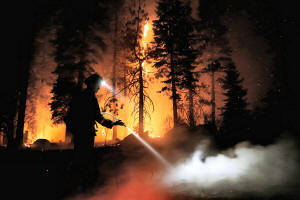Evacuees anxiously follow course of California fire near Lake Tahoe
 Send a link to a friend
Send a link to a friend
 [September 01, 2021] By
Sharon Bernstein [September 01, 2021] By
Sharon Bernstein
CARSON CITY, Nevada (Reuters) - Red Cross
officials who have turned a Carson City recreation center into a shelter
have tried to make evacuees from the wildfire raging near Lake Tahoe as
comfortable as possible.
Cots are placed at COVID-safe distances from each other on the gym
floor, each topped with a crisp white blanket. Urns of coffee wait at
the entrance.
But it is information that is most craved by those staying at the rec
center in western Nevada and others who have found their own shelter
after some 50,000 people were given evacuation orders because of the
Caldor fire across the state line in California.
Forest Service staff stood at the door of the rec center, pointing to a
poster-sized map on an easel as they answered questions from evacuees
about where the fire was in relation to people’s homes.
Cal Fire spokesman Henry Herrera told Reuters by phone Tuesday that two
large spot fires crept to within 3 miles of the southern boundary of
South Lake Tahoe, Calif., a town of some 22,000 about 30 miles southwest
of Carson City.

Officials said the fire was quite close on Tuesday to the unincorporated
community of Meyers, a former trading post and Pony Express station
about 6 miles from South Lake Tahoe that has one grocery store, a
hardware shop, a lumber yard and a handful of restaurants and shops.
Meyers residents are among those under evacuation orders.
“This thing is just unstoppable,” Lee England, who fled her South Lake
Tahoe apartment late Sunday, said as she sat outside the Carson City rec
center Tuesday evening.
Before leaving, the 47-year-old hip hop skate performer and instructor
initially thought – or hoped - she was seeing a storm in the distance.
“It was only wishful thinking that it was rain,” she said. “It was
smoke.”
The smell of smoke hung in the air in Carson City. When ash fell on the
back of England’s Boston terrier Bon Bon, she bent and gently plucked
the gray fleck from the dog’s black and white fur.
THEY'VE GOT TO SAVE IT
Inside the rec center, Joan, a 68-year-old retired paralegal who gave
only her first name, sat in the first row of cots, bent over her iPhone
watching fire updates being broadcast on Facebook from a community
meeting near Sacramento, the California capital.
Joan said she watched the updates daily and even had a favorite briefer,
a moustachioed fire official she described as particularly
straightforward.
Joan said she moved from San Francisco in 1994 after seeing a picture in
a real estate brochure of the house she now owns, built in the 1940s by
a prominent South Lake Tahoe family. She described the irises and golden
chain tree she planted in her garden, and the redwood paneling and nook
where she had placed her grandmother’s organ.
[to top of second column]
|

Patrick R., 27, a firefighter with Cal Fire sprays water on hot
spots as flames from the Caldor Fire burn through trees in Christmas
Valley near South Lake Tahoe, California, U.S., August 31, 2021.
REUTERS/Brittany Hosea-Small

“It’s unique. It’s special,” she said, and sobbed.
“They’ve got to save it.”
As of Tuesday, nearly 4,000 personnel and a squadron of over two
dozen water-dropping helicopters were assigned to the blaze, whose
cause remained under investigation.
"There is a substantial amount of resources right now dedicated to
protecting the homes and property in South Lake Tahoe,” U.S. Forest
Service spokeswoman Dana Walsh told Reuters by phone Tuesday
evening.
A National Weather Service red-flag warning for dangerously gusty
winds and extremely low humidity was posted for the Tahoe area
through Wednesday night. But Walsh said officials did not expect the
wind to push the fire toward South Lake Tahoe Tuesday evening.
Caldor has been burning since mid-August in the mountains east of
Sacramento. While it has not reached population centers such as
South Lake Tahoe, at least 669 structures were listed as destroyed
on Tuesday, most of them single-family homes, with 34,000 more
buildings considered threatened, Cal Fire spokesman Herrera said.
By Tuesday, the fire had charred more than 191,000 acres (77,300
hectares) of forest, some 14,000 acres (5,665 hectares) more than
the day before. Firefighters had managed to carve containment lines
around just 16% of its perimeter.
No deaths have been reported. Three firefighters and two civilians
were injured in recent days.
Only the Dixie fire, which has charred 771,000 acres (312,000
hectares) farther north in the Sierra, has burned more territory
this year than Caldor.

Both fires are among nearly two dozen raging across California and
scores of others elsewhere in the West, during a summer fire season
shaping up as one of the most destructive on record. The blazes have
been stoked by extremely hot, dry conditions that experts say are
symptomatic of climate change.
(Reporting by Sharon Bernstein in Carson City, Nevada; Additional
reporting by Steve Gorman in Los Angeles; Editing by Donna Bryson
and Kim Coghill)
[© 2021 Thomson Reuters. All rights
reserved.] Copyright 2021 Reuters. All rights reserved. This material may not be published,
broadcast, rewritten or redistributed.
Thompson Reuters is solely responsible for this content. |